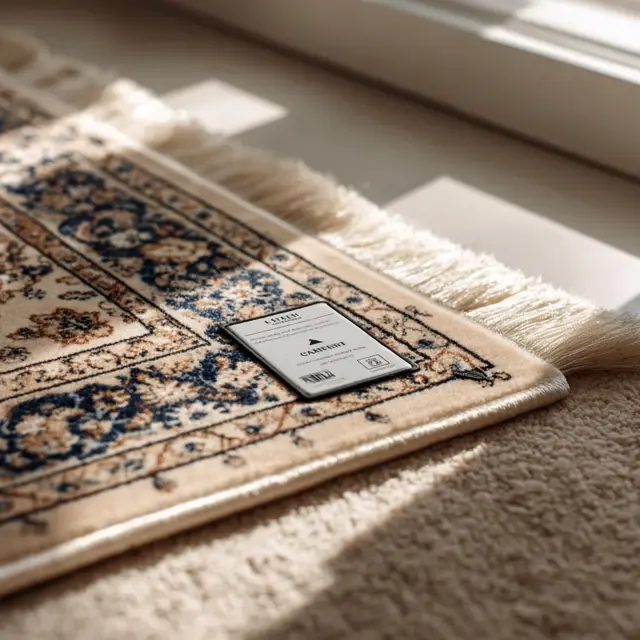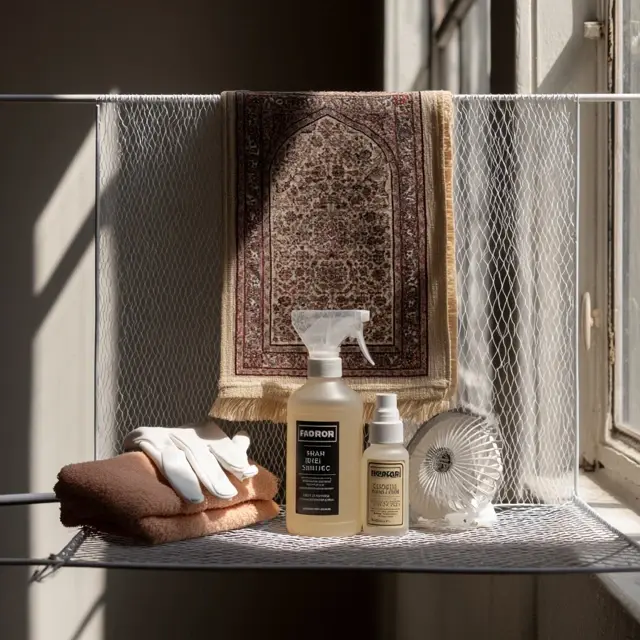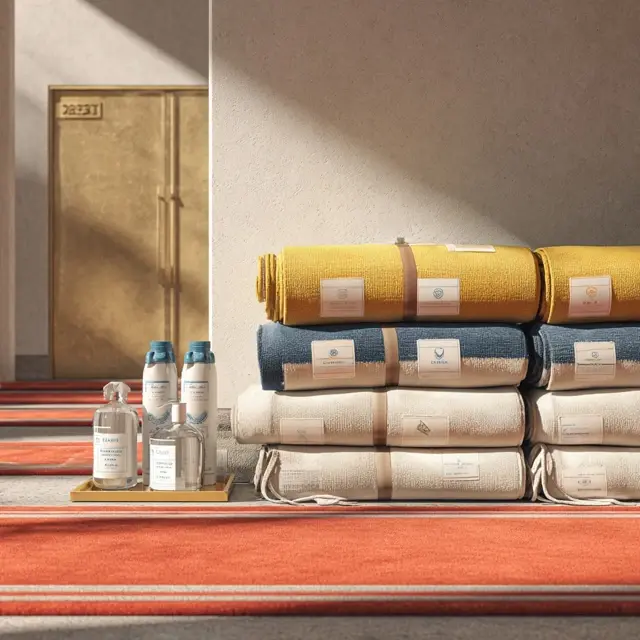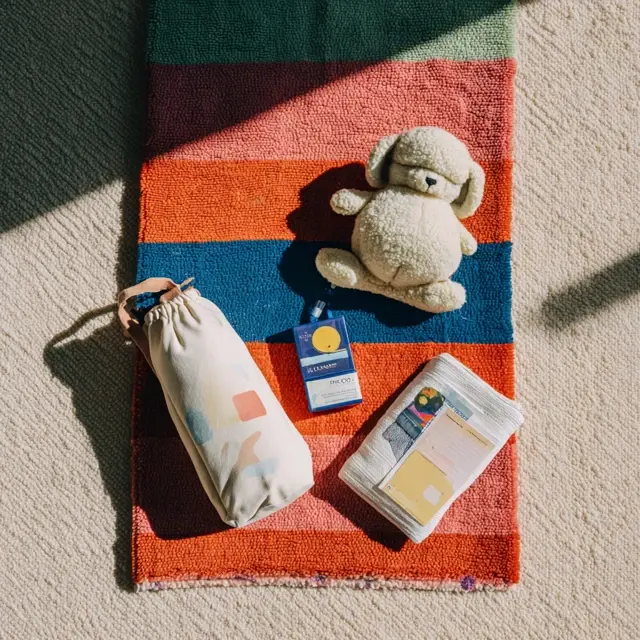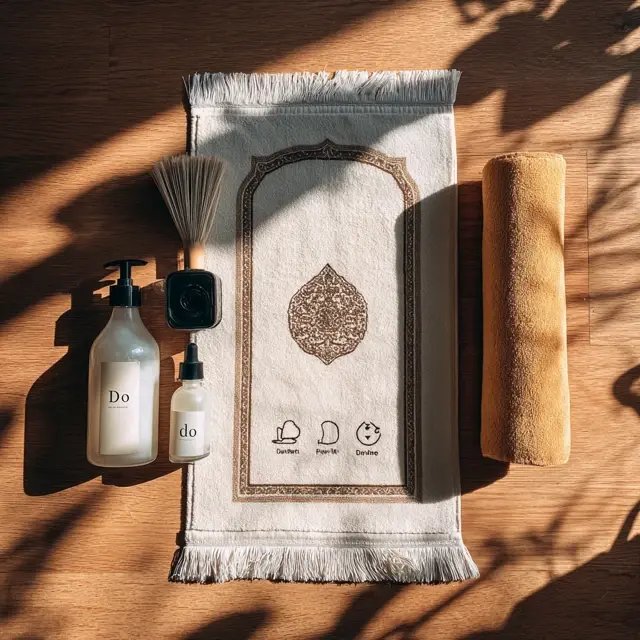Label Reading 101 for Prayer Mat Care
The small tag on your prayer mat is a roadmap for safe cleaning. With a few symbols and short phrases, it tells you how much water, what kind of detergent, whether heat is allowed, and how to dry without warping the backing or fading the design. Use this quick guide to translate those clues into confident care.
Start Here: What That Tag Is Really Telling You
- Face fiber: Cotton, polyester, microfiber, wool, or velvet pile.
- Backing: Textile-only (fabric), non-slip coating (latex/TPR), or foam/cushioned core.
- Care pathway: Wash (machine/hand), dry (flat/line/tumble), bleach permissions, iron limits, and any dry-clean codes.
Fiber & Backing: The Two Most Important Lines
Face Fiber Clues
- Cotton / Polyester: Usually cold, delicate, and low residue; responds well to extra rinse.
- Microfiber / Printed: Gentle chemistry, short contact time; avoid solvents and high heat.
- Wool / Velvet: Low-moisture methods, no scrubbing across the nap; look for “hand wash” or “dry clean” guidance.
Backing Types
- Textile only: Most flexible; brief immersion may be allowed if the label says so.
- Non-slip (Latex/TPR): Heat sensitive—expect “dry flat,” “no tumble,” “no iron.”
- Foam/cushion: “Spot clean only,” “no soak,” and air-dry are common—respect them to avoid warping.
Wash Symbols—What They Mean for a Prayer Mat
- Tub icon with 30° / 40°: Machine-wash up to that temp; choose cold delicate, mesh bag, and low spin.
- Tub with a hand: Hand wash—cool water, minimal agitation, press-and-lift motions.
- Tub crossed out: Do not wash—stick to surface cleaning or follow dry-clean symbols.
- Spiral crossed: Do not wring—press in towels to remove moisture.
Drying & Heat Icons—Read Before You Reach for a Dryer
- Square with horizontal line: Dry flat—best for backings and pile alignment.
- Square with vertical lines: Drip/line dry—compatible with textile backs; still avoid direct sun.
- Square with a circle (tumble): Rarely safe for mats; dots indicate heat level—when in doubt, don’t tumble.
- Iron icon (dots = heat): Only on textile backs and from the reverse through a press cloth; never on non-slip or foam.
Bleach & Solvents—Know the Limits
- Open triangle: Any bleach—uncommon for patterned mats; avoid unless stated.
- Triangle with stripes / “Non-chlorine only”: Oxygen-based products permissible; patch test first.
- Triangle crossed: No bleach—use mild detergent and low-moisture methods.
- Dry-clean circles (P/F/W): P or F means pro-solvent or hydrocarbon; W means professional wet-clean only.
Hidden Phrases That Change Your Method
- “Color may transfer” / “Wash separately”: Cold water, short contact time, and thorough rinse-blot.
- “Do not tumble” / “No heat”: Air-dry flat with a fan—protects coatings and adhesives.
- “No softener / No optical brightener”: These leave films that dull color and trap odor.
- “Spot clean only”: Surface tamping—no soaking the core or backing.
Temperature, Cycle & Spin—Practical Translation
- Temperature: 30°C (86°F) = cold; safer for dyes and adhesives.
- Cycle: “Gentle/Delicate” lowers agitation—essential for pile and prints.
- Spin: Low (≈400–800 RPM) to avoid creases and backing stress.
Patch-Test Protocol (60 Seconds of Insurance)
- Dab a hidden corner with cool water + a drop of mild detergent.
- Press with a white cloth. If dye transfers or texture shifts, downgrade to shorter, cooler, and lower-moisture care.
When Labels Are Missing or Vague
- Default to low-moisture surface cleaning, cool water only, and flat, shaded drying.
- Assume no heat for backings; never tumble unknown coatings.
- Document your method and result so you can repeat what works.
Buying Smart: Label Green Flags
- Clarity: “Face: 100% cotton; Back: TPR” beats “polyester blend.”
- Explicit limits: “Dry flat,” “No tumble,” “Cold only” show the brand tested construction.
- Care detail: Temperature + cycle + drying method builds confidence for long-term upkeep.
Quick Translator Card
- 🫧 30° = cold delicate, mesh bag, low spin
- 🧼 △ (stripes) = oxygen bleach only; patch test
- 🌀✖ = no tumble—dry flat with airflow
- 🧲• = low iron from back through a cloth (textile backs only)
- ⚪ P/F = professional solvent clean; ⚪ W = pro wet-clean
FAQs
Why does the backing restrict heat even if the face fiber is cotton?
Coatings and foam soften or ripple under heat. Follow the strictest component—usually the backing.
Can “line dry” mean I can hang a heavy, wet mat?
Support the weight—use two rods or a mesh rack to prevent stretching and edge stress.
What if the label says “washable,” but colors are deep and saturated?
Still patch test; opt for cold, gentle cycle, half-dose detergent, and an extra rinse.
Next Steps: Put the Label to Work
- Match your label’s pathway to the right technique for your mat.
Suggested internal link anchors: “Machine-Washing a Prayer Mat: Safe Settings,” “Hand-Washing a Prayer Mat: Gentle Method,” “Drying a Prayer Mat: Sun, Shade, or Indoors?”
